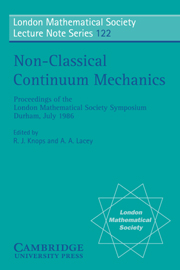 Non-Classical Continuum Mechanics
Non-Classical Continuum Mechanics Book contents
- Frontmatter
- FOREWORD
- Contents
- LIST OF PARTICIPANTS
- PART I PRINCIPAL LECTURES
- PART II SINGLE INVITED LECTURES
- Some Mathematical Problems Arising From the Oil Service Industry
- Randomly Diluted Inhomogeneous Elastic Networks near the Percolation Threshold
- Adaptive Anisotropy: An Example in Living Bone
- Stability of Elastic Crystals
- Optimal Bounds for Conduction in Two-Dimensional, Two-Phase, Anisotropic Media
- Rapid Flows of Granular Materials
- The Constrained Least Gradient Problem
- The Fusion of Physical and Continuum-Mechanical Concepts in the Formulation of Constitutive Relations for Elastic-Plastic Materials
- Singularities in Elliptic Non–Smooth Problems. Applications to Elasticity
- Solitons in Elastic Solids Exhibiting Phase Transitions
- On the Dynamics of Structural Phase Transitions in Shape Memory Alloy
- On the Homogenization of Some Free Boundary Problems
- The Point Interaction Approximation, Viscous Flow Through Porous Media, and Related Topics
Rapid Flows of Granular Materials
Published online by Cambridge University Press: 11 May 2010
- Frontmatter
- FOREWORD
- Contents
- LIST OF PARTICIPANTS
- PART I PRINCIPAL LECTURES
- PART II SINGLE INVITED LECTURES
- Some Mathematical Problems Arising From the Oil Service Industry
- Randomly Diluted Inhomogeneous Elastic Networks near the Percolation Threshold
- Adaptive Anisotropy: An Example in Living Bone
- Stability of Elastic Crystals
- Optimal Bounds for Conduction in Two-Dimensional, Two-Phase, Anisotropic Media
- Rapid Flows of Granular Materials
- The Constrained Least Gradient Problem
- The Fusion of Physical and Continuum-Mechanical Concepts in the Formulation of Constitutive Relations for Elastic-Plastic Materials
- Singularities in Elliptic Non–Smooth Problems. Applications to Elasticity
- Solitons in Elastic Solids Exhibiting Phase Transitions
- On the Dynamics of Structural Phase Transitions in Shape Memory Alloy
- On the Homogenization of Some Free Boundary Problems
- The Point Interaction Approximation, Viscous Flow Through Porous Media, and Related Topics
Summary
Abstract. We outline the derivation of balance laws, constitutative relations, and boundary conditions for the rapid flow of a granular material consisting of identical, smooth, nearly elastic, spheres. As an illustration, we consider the steady shearing flow maintained by the relative motion of two parallel boundaries, and treat, in detail, the exceptional situation in which the shear rate, the solid volume fraction, and the energy of the velocity fluctuations are uniform across the gap.
INTRODUCTION
When a granular material is sheared at a sufficiently high rate, the shear stress and the normal stress required to maintain its motion are observed to vary with the square of the shear rate (Bagnold (1954), Savage (1972), Savage & McKeown (1983), Savage & Sayed (1984), Hanes & Inman (1985a)). The interpretation of these observations is that, at high shear rates, the dominant mechanism of momentum transfer is collisions between grains, with the interstitial liquid or gas playing a relatively minor role.
There is an obvious analogy between the colliding macroscopic grains of a sheared granular material and the agitated molecules of a dense gas. There are also several important differences: collisions between grains are inevitably inelastic; typical grain flows involve spatial variations over far fewer grains than their molecular counterparts; and, consequently, the influence of boundaries is far more pervasive.
Exploiting the analogy, methods from the kinetic theory of dense gases have been adopted and extended to derive balance laws, constitutive relations, and boundary conditions for systems of macroscopic, dissipative, grains. Jenkins (1987) provides a brief review of this activity.
- Type
- Chapter
- Information
- Non-Classical Continuum MechanicsProceedings of the London Mathematical Society Symposium, Durham, July 1986, pp. 213 - 225Publisher: Cambridge University PressPrint publication year: 1987
- 19
- Cited by
